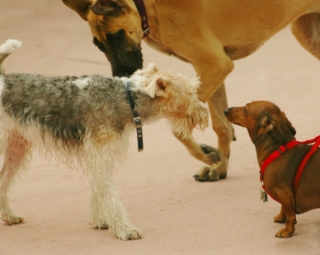The Evolution of Dog Daycare

Back when I started my dog daycare, I was a bit isolated as a dog trainer. It wasn’t until I joined the Association of Pet Dog Trainers that I became connected with other professional dog trainers all over the world. Through email forums and educational events, I was surprised to find out that a lot of trainers had a negative view of the dog daycare industry.
As I ventured further, I found that there was good reason for concern! In many cases the dog daycare experience can be highly detrimental to the well-being, behavior and training of the dogs who attend. For those who are working hard to teach their dogs basic manners and social skills, an improperly run dog daycare can unravel weeks of work in a single day!
By running my daycare according to accepted industry standards, I found that dogs were over-stimulated and out of control before lunch time. Employee turnover was very high because the dogs’ over-arousal and frequent squabbles were stressful and exhausting to manage.
I kept thinking that there had to be a better way. I spent 60 hours a week for the next five years figuring out a better way! My goal was to bring current dog behavior and training into the dog daycare experience. What I mean is that I shifted the focus from all day fun and exercise to a more balanced, behavior-based approach.
I was told that my clients would not stand for some of my innovations, like having the dogs crated nearly 50% of the time they were at daycare, but those warnings were incorrect. Clients were thrilled to find their dogs well-exercised, well-socialized and yet not completely exhausted at the end of the day.
I was told that it would not be cost effective to only allow 8 -10 dogs per employee on the play floors. The industry standard was 15 – 20. However, with the use of crates for rotation, I was able to have just as many dogs in the daycare, with fewer employees, fewer dogs on the floor at one time, more personal attention per dog and far fewer arguments or injuries.
The biggest bonus was that employees could concentrate on individual dog behavior and training. Recalls from play, sits from play, monitoring behavioral changes in individual dogs and ensuring that everyone was having a rich social experience became easy and natural. This not only improved the experience for the dogs, but reduced stress and increased learning experiences for employees, resulting in extremely reduced employee turnover.
The dog daycare industry can be so much more than a doggy playground. With the help of consumers, dog trainers, dog groomers and veterinarians, the dog daycare industry can become the central hub of a strong support network for dog owners. Improving the dog daycare industry will require all dog professionals to be informed of what dog daycare was, how it has changed and what it can become.
To this end, I am offering The Evolution of Dog Daycare seminar. My hope is that through education, innovation and creativity, the expectations of dog daycare can be raised to a level that supports the goal of having well-behaved, well-balanced and well-socialized dogs in our communities.
Trainers, vets and groomers need to be informed in order to confidently refer to high-quality dog daycares. Dog daycare owners need to think carefully about how their daily operations impact the dog’s experiences elsewhere in the community. Dog owners need to see through the marketing in order to know what to ask, what to look for and what to expect when choosing a dog daycare.
I hope you’ll join me in improving the dog daycare industry! Seminars are currently scheduled in the following locations:




